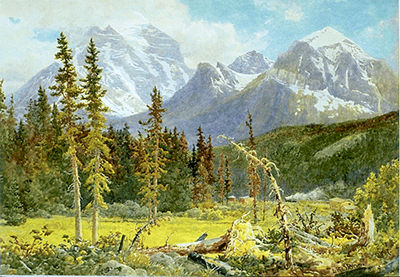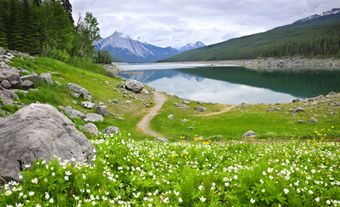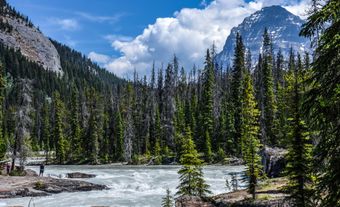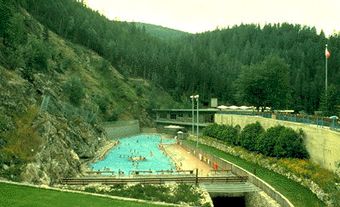The Canadian Rocky Mountains, or Rockies, are the Canadian section of the North American Rocky Mountains, a mountain range in western North America which extends from New Mexico in the south to Alaska in the North. Stretching across much of the British Columbia-Alberta boundary, the Rockies are bounded by the prairies to the east. The tallest peak is Mount Robson, with an elevation of 3,954 m. Many of the national parks in these mountains, such as Banff National Park, Jasper National Park, Yoho National Park, Kootenay National Park and Waterton-Glacier International Peace Park are UNESCO World Heritage Sites.
Description
The Rocky Mountains, North America's largest mountain system, are widely known for their vistas of spacious subalpine valleys and rugged, exposed rock faces. The Canadian segment of the Rockies extends 1,200 km from the American borders of British Columbia and Alberta to the Liard River Basin, flanked on the west by a distinct trench and on the east by rolling foothills. However, the Canadian Rockies of song, film, painting and postcard are in the Main Ranges, near the rail and highway routes through two mountain passes. These and other passes mark the southern boundary between British Columbia and Alberta and mark the Continental Divide, dividing the watersheds leading to the Pacific Ocean and those leading to either the Arctic Ocean, Hudson Bay or the Gulf of Mexico.
The Rocky Mountains are relatively tall, with the tallest peak being Mount Robson in British Columbia (elevation of 3,954 m). Mount Robson is the 137th tallest peak in North America. The tallest peaks in North America primarily exist within the Alaska Range in the United States (e.g. Mount Denali, elevation 6,190 m, and Mount Foraker, elevation 5,304 m), the Saint Elias Mountains in Canada (e.g. Mount Logan, elevation 5,959 m, and Mount St. Elias, elevation 5,489), and the Cordillera Neovolcanica in Mexico (e.g. Citlaltépetl, elevation 5,636, and Volcán Popocatépetl, elevation 5,413 m).

Wildlife and Plants
The Rocky Mountains are home to many species of plants and animals. Their unique alpine ecosystem and long slopes make them the perfect habitat for many of the best-known Canadian animals. Elk, mountain sheep, mountain goats, wolves, pika, marmots, deer and mountain lions are amongst their many inhabitants. Many species of birds, insects and fish are also integral to the Rocky Mountains’ ecosystem. Even one toad, the boreal toad, thrives in this unique landscape.
The valleys between peaks are often teeming with life and support some of the greatest biodiversity of the region. The slopes of the Rockies are often densely treed, with evergreens like spruce thriving in the cold environment. However, these trees thin out as they approach the tree line and are replaced with an alpine tundra.

Geological History
The Rocky Mountains are relatively young, much younger than the Appalachian Mountains in the United States. The Rocky Mountains were formed primarily during the Jurassic around 200 million years ago. During this period, the supercontinent of Pangea was breaking up along what is now the Atlantic Ocean. As a result, the continent of North America was being pushed westward, where it collided with many microcontinents. This collision resulted in the Cordilleran Orogeny, from which the Rocky Mountains were formed (see Geological Regions).
Did you know?
The Rocky Mountains are older than the Tyrannosaurus rex, which existed around 68 to 66 million years ago. They have also seen the creation and then disappearance of the Western Interior Seaway, a massive sea that split the North American continent during much of the Cretaceous (145 million years ago to 66 million years ago, ending with the asteroid impact which killed the non-avian dinosaurs), connecting the Arctic Ocean to the Gulf of Mexico. Nonetheless, they are considered a “young” geological formation, significantly younger than the Appalachian Mountains and the Canadian Shield.
Indigenous Peoples
Indigenous Peoples have lived in and around the Rocky Mountains for thousands of years — the oldest archeological sites in the area date back to at least 13,000 years ago. The Ktunaxa (Kootenay), Secwépemc (Shuswap), Piikani (Blackfoot), Siksika (Blackfoot), Kainai (Blackfoot), Atsina (Gros Ventre), Tsuut’ina (Sarcee), Nakoda (Stoney), Nehiyawak (Cree) and Métis are amongst the many nations with a deep connection to this land. To many, these mountains are a sacred place.

European Explorers
European explorers did not cross the Rockies until the late 1700s, at which point they approached by northern routes. Alexander Mackenzie was the first (1793) to cross the Rockies, using the Peace River. On the same route, Simon Fraser established the first Rocky Mountain trading post at Hudson's Hope (1805). Kicking Horse Pass was chosen in 1882 for the Canadian Pacific Railway link between the Prairies and coastal British Columbia.

National Parks
Once the Canadian Rockies were connected to the rest of Canada via railway, it was not long before resorts and attractions began being constructed. Banff National Park was established in 1885, making it the oldest national park in Canada. It was followed closely by Yoho National Park and Glacier National Park, established in 1886. Waterton Lakes National Park was established in 1895. Jasper National Park was established a few years later in 1907. Mount Revelstoke National Park was established in 1914. Finally, in 1920, Kootenay National Park was established.
Together, four of these national parks (Banff, Yoho, Jasper and Kootenay) form the largest body of mountain parkland in the world and were declared a UNESCO World Heritage Site in 1984.
In 1932, Waterton Lakes National Park was united with the United States’ Glacier National Park, creating the world’s first international peace park. The Waterton-Glacier International Peace Park was designated a UNESCO World Heritage Site in 1995.

Economic Importance
The Rocky Mountains have had a significant impact on the Canadian economy. Historically, much of this impact was from natural resource extraction. Today, natural resource extraction remains an important part of its economy, though tourism plays an ever-increasing role.
Industry
When the Canadian Pacific Railway built a rail line through the Crowsnest Pass area of the border ranges in 1898, the Rocky Mountains were opened for coal and mineral extraction from mine development. Open-pit mines near Sparwood and Elkford, British Columbia, have greatly expanded the area's coal production since the 1960s.
Additionally, the southern Alberta foothills of the Rockies have been a cattle ranching centre since the 1870s. Natural gas drilling has also progressed into foothill country in recent decades.
North of the Kakwa River, the Rockies are entirely in British Columbia. They subside to modest heights (maximum 2,542 m) with rounded, often timbered summits and little evidence of glaciation. As a result, the lumber and wood industries followed highway (1952) and railway (1958) construction northeast from Prince George. Open-pit coal mines at Quintette and Bullmoose mountains in the British Columbia foothills started in 1983. The closure of the Quintette coal mine in 2000 forced nearly half of the residents of the town of Tumbler Ridge to leave. The higher Muskwa Ranges, north of the Peace River, are penetrated by the Alaska Highway but remain less developed.

Tourism
Known for their astounding natural beauty, the Canadian Rocky Mountains have seen large amounts of tourism both historically and today. The national parks of the Canadian Rockies (Banff National Park, Jasper National Park, Yoho National Park, Kootenay National Park, Waterton Lakes National Park, Glacier National Park and Mount Revelstoke National Park) collectively receive over 9 million visitors annually.
This region provides many recreation opportunities both within and outside of these national parks. Skiing, snowboarding, hiking, mountain biking, winter biking, rock climbing, canoeing, kayaking, paragliding, hand-gliding and trail running are popular outdoor sports. Various aerial parks, via ferratas, ziplines, helicopter tours and horseback riding trails, allow visitors to explore the area in unique ways. The Rockies are also a hotspot for photography, birding and wildlife viewing, and they have inspired a lot of Canadian art.

Environmental Concerns
Much of Canada’s landscape is being impacted by climate change as well as various forms of environmental degradation. The Canadian Rocky Mountains are no exception to this.
In the Canadian Rockies, the rate of glacial melt has increased eightfold since 2011. As a result, many of the iconic glaciers within this mountain range are shrinking quickly, even though some regions may receive as much as 7 m of snow annually. The Athabasca Glacier of the Columbia Icefield has been receding for the past 125 years and saw the greatest amount of melting in 2023 compared to the previous ten years. Since 1890, the Athabasca Glacier has retreated more than 1.5 km and continues to retreat over 5 m annually.
Glaciers melting can have a very profound impact on the rivers that the glacier feeds, potentially causing either floods or droughts.

 Share on Facebook
Share on Facebook Share on X
Share on X Share by Email
Share by Email Share on Google Classroom
Share on Google Classroom






